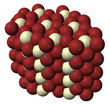Praseodymium(III) chloride is the inorganic compound with the formula PrCl3. Like other lanthanide trichlorides, it exists both in the anhydrous and hydrated forms. It is a blue-green solid that rapidly absorbs water on exposure to moist air to form a light green heptahydrate.

| |||
| |||
| Names | |||
|---|---|---|---|
| IUPAC name
Praseodymium(III) chloride
| |||
| Other names
Praseodymium chloride; praseodymium trichloride
| |||
| Identifiers | |||
3D model (JSmol)
|
|||
| ECHA InfoCard | 100.030.710 | ||
PubChem CID
|
|||
| UNII | |||
CompTox Dashboard (EPA)
|
|||
| |||
| |||
| Properties | |||
| PrCl3 | |||
| Molar mass | 247.24 g/mol (anhydrous) 373.77 g/mol (heptahydrate) | ||
| Appearance | blue-green solid (anhydrous) light green solid (heptahydrate) | ||
| Density | 4.02 g/cm3 (anhydrous) 2.250 g/cm3 (heptahydrate) | ||
| Melting point | 786 °C (1,447 °F; 1,059 K) | ||
| Boiling point | 1,710 °C (3,110 °F; 1,980 K) | ||
| 104.0 g/100 ml (13 °C) | |||
| +44.5·10−6 cm3/mol | |||
| Structure | |||
| hexagonal (UCl3 type), hP8 | |||
| P63/m, No. 176 | |||
| Tricapped trigonal prismatic (nine-coordinate) | |||
| Hazards | |||
| Occupational safety and health (OHS/OSH): | |||
Main hazards
|
Irritant | ||
| Related compounds | |||
Other anions
|
Praseodymium(III) oxide, Praseodymium(III) fluoride Praseodymium bromide praseodymium iodide | ||
Other cations
|
Cerium(III) chloride Neodymium(III) chloride | ||
Except where otherwise noted, data are given for materials in their standard state (at 25 °C [77 °F], 100 kPa).
| |||
Preparation
editPraseodymium(III) chloride is prepared by treating praseodymium metal with hydrogen chloride:[1][2]
- 2 Pr + 6 HCl → 2 PrCl3 + 3 H2
It is usually purified by vacuum sublimation.[3]
Hydrated salts of praseodymium(III) chloride can be prepared by treatment of either praseodymium metal or praseodymium(III) carbonate with hydrochloric acid:
- Pr2(CO3)3 + 6 HCl + 15 H2O → 2 [Pr(H2O)9]Cl3 + 3 CO2
PrCl3∙7H2O is a hygroscopic substance, that will not crystallize from the mother liquor unless it is left to dry in a desiccator. Anhydrous PrCl3 can be made by thermal dehydration of the hydrate at 400 °C in the presence of ammonium chloride, the so-called ammonium chloride route.[3][4][5] Alternatively the hydrate can be dehydrated using thionyl chloride.[3][6]
Reactions
editPraseodymium(III) chloride is Lewis acidic, classified as "hard" according to the HSAB concept. Rapid heating of the hydrate may cause small amounts of hydrolysis.[3] PrCl3 forms a stable Lewis acid-base complex K2PrCl5 by reaction with potassium chloride; this compound shows interesting optical and magnetic properties.[1]
Aqueous solutions of praseodymium(III) chloride can be used to prepare insoluble praseodymium(III) compounds. For example, praseodymium(III) phosphate and praseodymium(III) fluoride can be prepared by reaction with potassium phosphate and sodium fluoride, respectively:
- PrCl3 + K3PO4 → PrPO4 + 3 KCl
- PrCl3 + 3 NaF → PrF3 + 3 NaCl
- 2PrCl3 + 3 Na2CO3----> Pr2CO3 + 6NaCl
When heated with alkali metal chlorides, it forms a series of ternary (compounds containing three different elements) materials with the formulae MPr2Cl7, M3PrCl6, M2PrCl5, and M3Pr2Cl9 where M = K, Rb, Cs.[7]
References
edit- ^ a b J. Cybinska; J. Sokolnicki; J. Legendziewicz; G. Meyer (2002-07-17). "Spectroscopic and magnetic studies of the ternary praseodymium chloride K2PrCl5". Journal of Alloys and Compounds. 341: 115–123. doi:10.1016/S0925-8388(02)00089-0.
- ^ L.F. Druding; J.D. Corbett (1961-06-01). "Lower Oxidation States of the Lanthanides. Neodymium(II) Chloride and Iodide". J. Am. Chem. Soc. 83 (11): 2462–2467. doi:10.1021/ja01472a010.
- ^ a b c d F.T. Edelmann; P. Poremba (1997). Synthetic Methods of Organometallic and Inorganic Chemistry. Vol. 6. Stuttgart: Georg Thieme Verlag. ISBN 978-31-319-3921-0.
- ^ M.D. Taylor; P.C. Carter (April 1962). "Preparation of anhydrous lanthanide halides, especially iodides". J. Inorg. Nucl. Chem. 24 (4): 387–391. doi:10.1016/0022-1902(62)80034-7.
- ^ J. Kutscher; A. Schneider (September 1971). "Notiz zur Präparation von wasserfreien Lanthaniden-Haloge-niden, Insbesondere von Jodiden". Inorg. Nucl. Chem. Lett. (in German). 7 (9): 815–819. doi:10.1016/0020-1650(71)80253-2.
- ^ J.H. Freeman; M.L. Smith (October 1958). "The preparation of anhydrous inorganic chlorides by dehydration with thionyl chloride". J. Inorg. Nucl. Chem. 7 (3): 224–227. doi:10.1016/0022-1902(58)80073-1.
- ^ Gerd Meyer (1990). "Ternary Chlorides and Bromides of the Rare-Earth Elements". Inorganic Syntheses. 30: 72–81. doi:10.1002/9780470132616.ch15.
Further reading
edit- CRC Handbook of Chemistry and Physics (58th edition), CRC Press, West Palm Beach, Florida, 1977.
- N. N. Greenwood, A. Earnshaw, Chemistry of the Elements, Pergamon Press, 1984.
- S. Sugiyama, T. Miyamoto, H. Hayashi, M. Tanaka, J. B. Moffatt, "Effects of chlorine additives in the gas- and solid-phases on the oxidative dehydrogenation of ethane over praseodymium oxide", Journal of Molecular Catalysis A, 118, 129-136 (1997).
- Druding L. F.; Corbett J. D.; Ramsey B. N. (1963). "Rare Earth Metal-Metal Halide Systems. VI. Praseodymium Chloride". Inorganic Chemistry. 2 (4): 869–871. doi:10.1021/ic50008a055.

